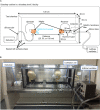Effectiveness of Face Masks in Preventing Airborne Transmission of SARS-CoV-2
- PMID: 33087517
- PMCID: PMC7580955
- DOI: 10.1128/mSphere.00637-20
Effectiveness of Face Masks in Preventing Airborne Transmission of SARS-CoV-2
Abstract
Guidelines from the CDC and the WHO recommend the wearing of face masks to prevent the spread of coronavirus (CoV) disease 2019 (COVID-19); however, the protective efficiency of such masks against airborne transmission of infectious severe acute respiratory syndrome CoV-2 (SARS-CoV-2) droplets/aerosols is unknown. Here, we developed an airborne transmission simulator of infectious SARS-CoV-2-containing droplets/aerosols produced by human respiration and coughs and assessed the transmissibility of the infectious droplets/aerosols and the ability of various types of face masks to block the transmission. We found that cotton masks, surgical masks, and N95 masks all have a protective effect with respect to the transmission of infective droplets/aerosols of SARS-CoV-2 and that the protective efficiency was higher when masks were worn by a virus spreader. Importantly, medical masks (surgical masks and even N95 masks) were not able to completely block the transmission of virus droplets/aerosols even when completely sealed. Our data will help medical workers understand the proper use and performance of masks and determine whether they need additional equipment to protect themselves from infected patients.IMPORTANCE Airborne simulation experiments showed that cotton masks, surgical masks, and N95 masks provide some protection from the transmission of infective SARS-CoV-2 droplets/aerosols; however, medical masks (surgical masks and even N95 masks) could not completely block the transmission of virus droplets/aerosols even when sealed.
Keywords: COVID-19; N95 masks; SARS-CoV-2; aerosols; droplets; face masks.
Copyright © 2020 Ueki et al.
Figures



Comment in
-
Besser geschützt mit FFP2-Masken.MMW Fortschr Med. 2021 Feb;163(2):10. doi: 10.1007/s15006-021-9573-8. MMW Fortschr Med. 2021. PMID: 33527263 Free PMC article. German. No abstract available.
References
-
- Berg EB, Picard RJ. 2009. In vitro delivery of budesonide from 30 jet nebulizer/compressor combinations using infant and child breathing patterns. Respir Care 54:1671–1678. - PubMed
Publication types
MeSH terms
Substances
Grants and funding
LinkOut - more resources
Full Text Sources
Other Literature Sources
Miscellaneous
